Detroit Has a New Currency?
By Joe LeBlanc (Mich-Matist, Summer 2009)
In today's tough economic times, many are seeking ways to increase and maintain their business. Perhaps today more than ever, we are forced to debate “Free Trade” versus “Buy Local”. “Free Trade” advocates that a product may be sold
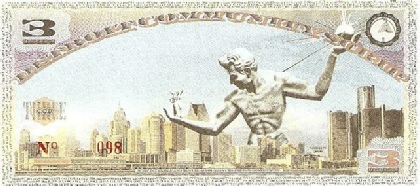 anywhere in the world, without burdensome protectionist taxes regardless of it's country of manufacture. The counter “Buy Local” argument founds itself on the ideal that one should buy locally-made products in an effort to keep one’s neighbors employed. Michigan is especially familiar with this debate, as the Big Three automakers struggle to maintain market share. If you buy from a local business, does that help keep your neighbor employed? Help keep you employed? Help keep your retirement pension check sound? Some local Detroit area businesses are saying yes.
anywhere in the world, without burdensome protectionist taxes regardless of it's country of manufacture. The counter “Buy Local” argument founds itself on the ideal that one should buy locally-made products in an effort to keep one’s neighbors employed. Michigan is especially familiar with this debate, as the Big Three automakers struggle to maintain market share. If you buy from a local business, does that help keep your neighbor employed? Help keep you employed? Help keep your retirement pension check sound? Some local Detroit area businesses are saying yes.
Local businessmen Jerry Belanger, Tim Tharp and John Linardos have created a local currency called Detroit Cheers. The theory behind the currency is to spend your money to support local merchants.
The intent of this article is not to debate the issue of “Free Trade” versus “Buy Local,” but rather to offer a numismatic prospective on their endeavor.
Mr. Belanger operates the Park Bar at 2040 Park Avenue near Comerica Park in downtown Detroit. He is the originator of the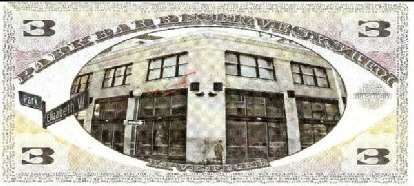 idea of this local currency, and he gained the support of two other businesses for the initial launch of Detroit Cheers. Mr. Tharp operates Grand Trunk Pub (Foran's) at 612 Woodward, while Mr. Linardos is from the Motor City Brewing Works which is located at 470 W Canfield, near Wayne State University's Detroit campus. At the current time, these three are the only issuers of the Cheers. The currency is denominated at Three Cheers, which in turn is backed by the issuers at $3 US Dollars.
idea of this local currency, and he gained the support of two other businesses for the initial launch of Detroit Cheers. Mr. Tharp operates Grand Trunk Pub (Foran's) at 612 Woodward, while Mr. Linardos is from the Motor City Brewing Works which is located at 470 W Canfield, near Wayne State University's Detroit campus. At the current time, these three are the only issuers of the Cheers. The currency is denominated at Three Cheers, which in turn is backed by the issuers at $3 US Dollars.
All three issues are promised to be accepted by the other two merchants, and they are attempting to bring on more merchants soon. Each issuing establishment has their own custom reverse on the currency while the front shows the Detroit skyline, and the statue The Spirit of Detroit. The statue stands at the entrance to the City-County Building (also known as the Coleman Young Municipal Building) on Jefferson Avenue in the heart of downtown Detroit.
The Park Bar reverse shows a picture of the building they operate from, along with the words “Park Bar Reserve System / Live Free”. In a small font around the main element is a an explanation of the purpose of the Cheers system: the “Buy Local” argument.
The Grand Trunk Pub reverse is the most complex of the current three issues. It contains their phone number in a format that 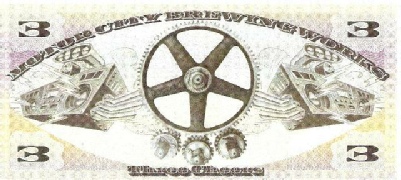 looks like a serial number, along with numerous other elements. This bill looks the most like an advertising flyer against it's peers, as opposed to a monetary motif.
looks like a serial number, along with numerous other elements. This bill looks the most like an advertising flyer against it's peers, as opposed to a monetary motif.
The artist who created the artwork used on the bills is Steve Adams, 31, of Livonia. He has other works of art on display at the Park Bar. The author was unable to determine who printed the bills and the method of printing.
The bills are serial numbered on the front over the skyline in red ink. Numbers 1-500 have the Park Bar reverse, 501-1000 the Motor City Brewing Works reverse, and 1001-1500 the Grand Trunk Pub option. The bills were initially printed and started to be released on a cotton blend paper. This was found to be unsatisfactory, due to it's feel and wear ease. As the bills that were issued on this type of paper are returned to the merchant, they are taken from circulation, destroyed, and replaced with a new bill of the same serial number. The new notes are printed on a higher quality paper with a plastic polymer. Other then the paper type, these replacement bills are identical. Unlike modern Federal Reserve Notes, they do not contain a Star suffix to denote replacement. Both paper types are in circulation, but according to the merchants, only one of a serial number exists in circulation.
The replacement notes are kept unissued at the merchant until the initial bill is destroyed. So, theoretically, if a mistake is made, there could be two bills out with the same serial number. “Series 2009” is denoted on the front. The “3” in the lower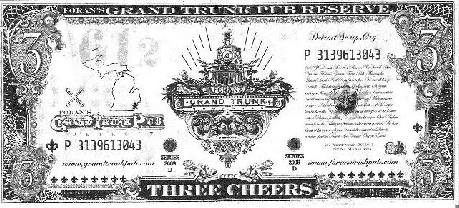 front corner is reflective and changes color based on the angle viewed.
front corner is reflective and changes color based on the angle viewed.
While any merchant may accept the Cheers as a payment, they are not required to do so by law as is the case with Federal Reserve Notes. Mr. Belanger hopes to bring other merchants into the program as issuers, each with their own reverse design. A merchant who accepts Cheers must still pay taxes on his sales and profit.
If you would like to read further on the Detroit Cheers you may wish to consult the Detroit News of March 23, 2009. Forbes Magazine and USA Today also did articles.
Regardless of one’s position on “Free Trade” versus. “Buy Local,” the Cheers will remain interesting examples of Michigan numismatics. Collectors wishing to add examples to their collection may visit any of the issuing merchants or ask at their favorite dealer.


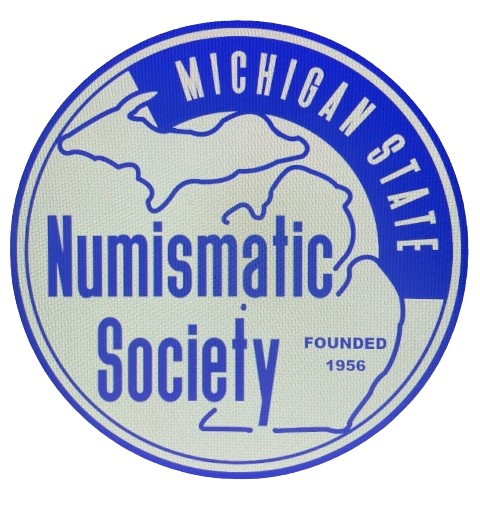
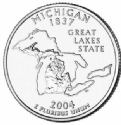






 anywhere in the world, without burdensome protectionist taxes regardless of it's country of manufacture. The counter “Buy Local” argument founds itself on the ideal that one should buy locally-made products in an effort to keep one’s neighbors employed. Michigan is especially familiar with this debate, as the Big Three automakers struggle to maintain market share. If you buy from a local business, does that help keep your neighbor employed? Help keep you employed? Help keep your retirement pension check sound? Some local Detroit area businesses are saying yes.
anywhere in the world, without burdensome protectionist taxes regardless of it's country of manufacture. The counter “Buy Local” argument founds itself on the ideal that one should buy locally-made products in an effort to keep one’s neighbors employed. Michigan is especially familiar with this debate, as the Big Three automakers struggle to maintain market share. If you buy from a local business, does that help keep your neighbor employed? Help keep you employed? Help keep your retirement pension check sound? Some local Detroit area businesses are saying yes.  idea of this local currency, and he gained the support of two other businesses for the initial launch of Detroit Cheers. Mr. Tharp operates Grand Trunk Pub (Foran's) at 612 Woodward, while Mr. Linardos is from the Motor City Brewing Works which is located at 470 W Canfield, near Wayne State University's Detroit campus. At the current time, these three are the only issuers of the Cheers. The currency is denominated at Three Cheers, which in turn is backed by the issuers at $3 US Dollars.
idea of this local currency, and he gained the support of two other businesses for the initial launch of Detroit Cheers. Mr. Tharp operates Grand Trunk Pub (Foran's) at 612 Woodward, while Mr. Linardos is from the Motor City Brewing Works which is located at 470 W Canfield, near Wayne State University's Detroit campus. At the current time, these three are the only issuers of the Cheers. The currency is denominated at Three Cheers, which in turn is backed by the issuers at $3 US Dollars.  looks like a serial number, along with numerous other elements. This bill looks the most like an advertising flyer against it's peers, as opposed to a monetary motif.
looks like a serial number, along with numerous other elements. This bill looks the most like an advertising flyer against it's peers, as opposed to a monetary motif.  front corner is reflective and changes color based on the angle viewed.
front corner is reflective and changes color based on the angle viewed.